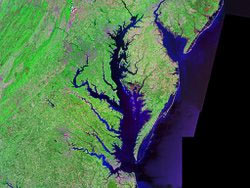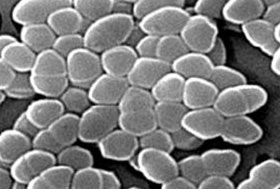Just how many enterococci are in the Bay?
Before we start actually measuring things, let’s think about how we could make some estimates. Specifically, how could we estimate how many enterococci are in the Bay right now?
Wow.
Personally, I deal with this stuff everyday, and I still have no clue. So don’t think it’s some kind of trick question. Here’s what I do know:
- “Good” water quality is 20 cells per 100 mL of water, while “bad” is anything over 200.
- A cubic meter of water is the same as a cube of water that is 1000mLs on each side.
- The average depth of the Bay is 21 feet.
- The great physicist Richard Feynman has championed this kind of estimation problem for building scientific intuition (ok, I know that wasn’t directly helpful, sorry).
So... where do we start? If we knew how much water was in the Bay, we could use that to estimate the range of enterococci depending on water quality. So, how can we figure out how much water is in the Bay?
How big is the Bay watershed? |
|
|---|---|
| The Bay watershed stretches from upstate New York to Virginia, which would take about 8 hours to drive, so it must be... | |
| Let’s convert that to metric right away. A quick google search shows me that 1 mile = 1.6 kilometers, so that’s... | |
| the watershed is about a third as wide as it is long, so that’s ... | |
| making total watershed area ... | |
Certainly we could have looked up the watershed area, but we're probably within a factor of 2, which is pretty good for an estimation problem.
What's that in square meters? |
|
|---|---|
| We have to multiply km^2 by (1000*1000) to get m^2 | |
| Let's try the trick of tens: 240,000 * 1000 * 1000 is the same as | |
| Or scientific notation | |
OK, now we have an estimate for the land area in the watershed, but what about the area under water? It's a lot smaller...
| Maybe 1% of the watershed is actually under water, so that would be 24 with 8 zeros, or... | |
| The average depth of that water is 21 feet, which is (in metric)... | |
| So the volume of water (area * depth) is about... | |
| Remember that a cubic meter is 1000mLs on each side, so to convert to mLs we have to multiply by | |
| which gives us... | |
| or in English... | |
So let's get a range, depending on whether water quality is good or bad.
| If water quality is good, say 10 enterococci / 100 mL, which is the same as 1 per 10, so that's... | |
| If water quality is bad, say 200 enterococci / 100 mL, which is the same as 2 per 1, so that's... | |
There are a couple of things to notice about these calculations.
First, I was awfully cavalier with the numbers, rounding pretty much whenever I felt like it. And actually, this is OK – because none of these numbers are very exact in the first place. It would be pretty silly to carry out calculations to 5 decimal places when I don’t even know whether the average number of enterococci is closer to 10 or 200 ... when the volume of water in the Bay is fluctuating all the time with the rainfall ... when I don’t even know exactly how big the watershed is.
Secondly, scientific notation becomes almost a necessity. Otherwise it would be really hard to keep track of all those zeros. And, unlike rounding, adding or dropping a few zeros WOULD make a huge difference in the final answer. Luckily scientific notation gives us an easy way to count the zeros.
So just how accurate is 2 to 40 million trillion? My professional estimate is “within a couple orders of magnitude”. That means I think the real number is somewhere in the million billions. And that’s as close as I can get with estimation.
For a point of comparison, there are about 100 trillion bacteria living in your body right now, so 2 million trillion is not really all that far-fetched...
Copyright University of Maryland, 2007
You may link to this site for educational purposes.
Please do not copy without permission
requests/questions/feedback email: mathbench@umd.edu


